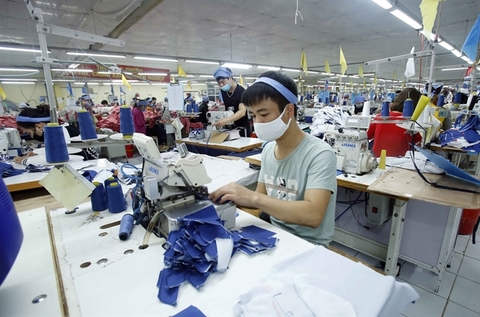
Textile and garment businesses are struggling to make use of free trade agreements, since most fabrics and other materials have to be imported. — VNA Photo Pham Kien
Viet Nam’s underdeveloped fabric production is making it difficult for textile and garment businesses to take advantage of free trade agreements, including the Europe – Viet Nam FTA (EVFTA).
The textile and garment industry exports nearly US$40 billion worth of products and requires around 10 billion metres of fabric each year.
The rate of domestic materials used by textile and garment businesses in Viet Nam is only about 40-45 per cent, according to the Ministry and Industry and Trade.
Viet Nam’s fabric industry produces around 2.3 billion metres of fabric a year, meeting only 25 per cent of the country’s demand. Over 7 billion metres of fabric material for production and export is imported from China, Taiwan and Korea.
In 2019, Viet Nam imported around $13 billion worth of fabric for the textile and garment industry. The amount of fabric produced domestically is often used to make low or medium quality clothing, and typically does not meet the requirements of clothing manufacturing and exporting businesses.
Tran Tuan Anh, Minister of Industry and Trade, said the country’s production of cotton, fibres and dyes does not satisfy the textile and garment industry’s demand.
Not enough attention is being given to dyeing technology and environmental protection to develop the textile dyeing industry, so businesses are reluctant to invest in textile production or form start-ups in fashion design.
Viet Nam’s textile and garment industry focuses mostly on manufacturing, with low added value.
While the industry has many opportunities from Viet Nam’s free trade agreements with other economies, around 60 per cent of exports comes from FDI companies.
The EVFTA’s rules of origin regarding textiles and garments is referred to as “from fabric onward”, meaning a garment product’s fabric has to be woven, finished, cut, and sewn in Viet Nam.
Truong Van Cam, deputy chairman of the Viet Nam Textile and Apparel Association, said that due to the lack of fabric materials, FTA rules of origin make it harder for businesses to use their values.
Investment in fabric production has faced challenges including a lack of funds and expensive technologies. As a result, while the textile and garment industry has seen exports rise over the years, imports of fabric materials have also risen.
An investment of around $30 billion is needed in order for the industry to be able to produce the remaining 8 billion metres of fabric, according to the association.
Luong Hoang Thai, director of the Multilateral Trade Policy Department under the Ministry of Industry and Trade, said the EVFTA’s rules of origin allow businesses to import fabric from Korea (which has an FTA with the EU), but Viet Nam and Korea would have to hammer out technical specifications and decide how to examine and confirm the origin of the fabric.
Nevertheless, the amount of fabric imported from Korea only makes up 15.2 per cent of imports, and fabric from China and Taiwan can be cheaper than from Korea.
Than Duc Viet, general director of the textile and garment company May 10, told Dau Tu Newspaper that the industry should focus on investing in automation to save costs and maximise profits, adding that the company’s automation helps it deal with challenging stages that require a great deal of precision. – VNS